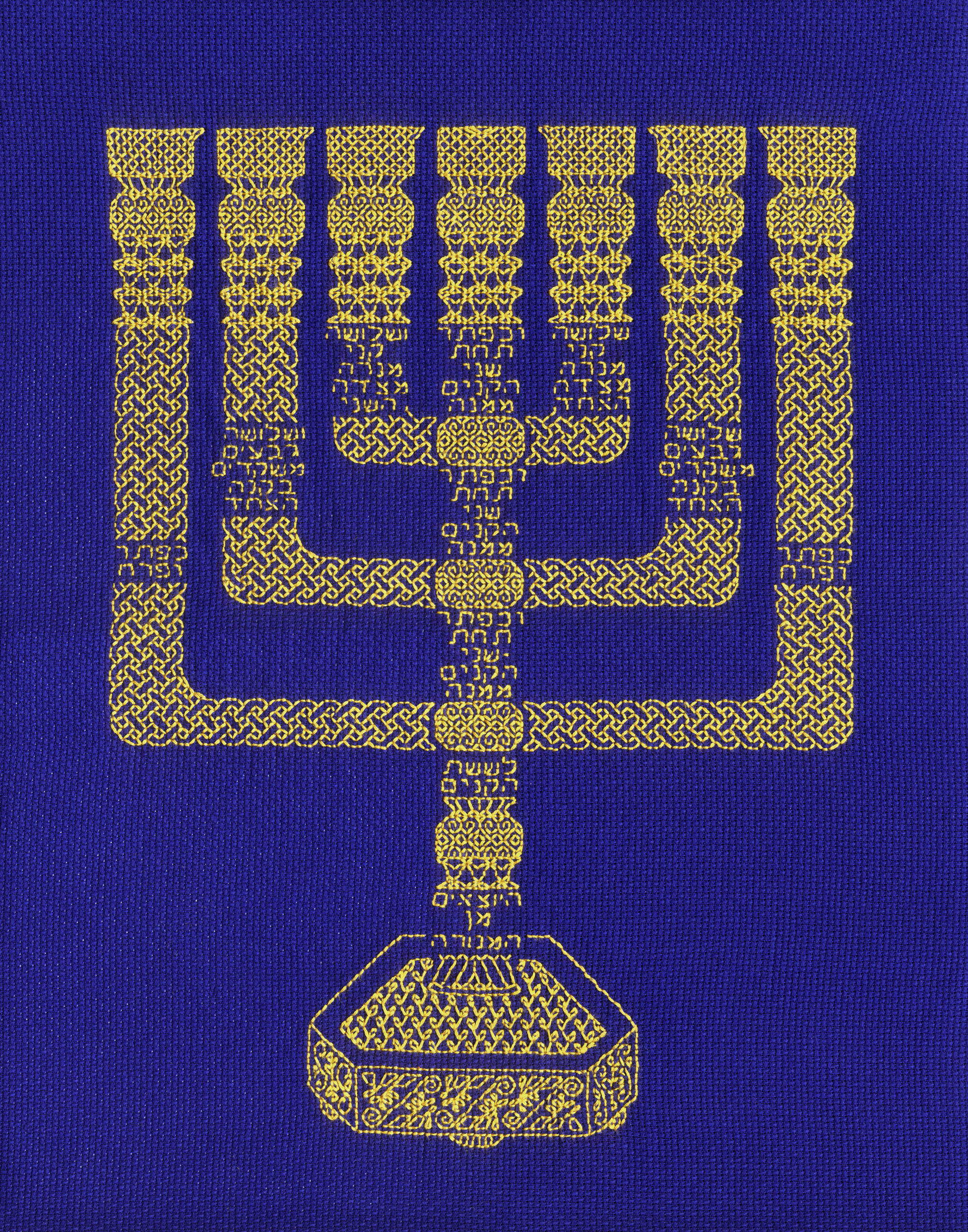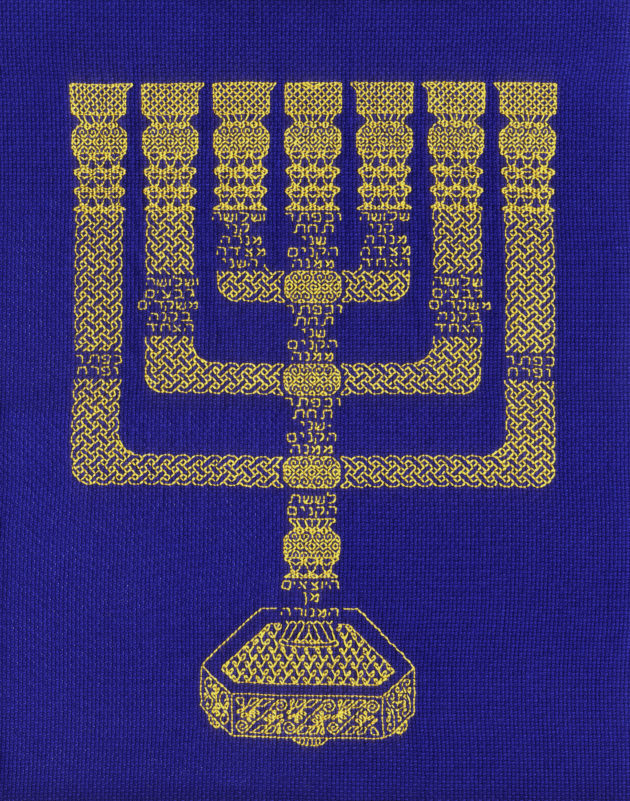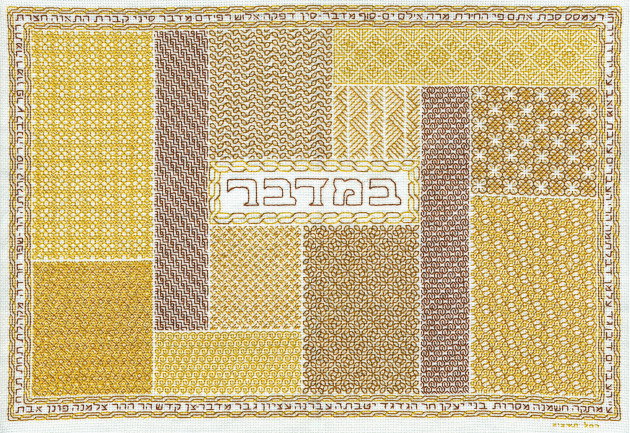
Embroidering a Jewish Life
In contrast, the process of designing and creating the embroidery is not about seeking permanence. For me, it has become a potent practice of living Torah and enacting Jewish life, rather than documenting myself for future generations. These experiences unfold in the offering of a drasha, a textual commentary, within the design itself, and indeed, in the repetitive glide of the needle through the fabric.
Jewish life is built around repetition, as can be attested by anyone who has slogged through a Torah reading about details of Sanctuary construction or particulars of sacrificial offerings. The former, including the lampstand of the Sanctuary, was a permanent aspect of Israelite material culture. In contrast, we who have fallen in love with our babies’ peculiar little scents fully appreciate that the fleeting sweet savors of the sacrifices might have ingratiated an ancient Israelite with the Deity.

Lampstand, 2016, Rachel Braun. Scan by Philip Bookman.
Perhaps it’s the statistician in me that is so attracted to these “boring,” repetitive verses. The verse that is worked into “Lampstand,” pictured above (2016) includes this construction detail: “a knob beneath two stems, from it, a knob beneath two stems, from it, and a knob beneath two stems, from it, for the six stems that issue from the Lampstand” (Exodus 25:35, translation by Everett Fox). Hearing that verse 0f Torah read aloud, emphatically, made me want to embroider the knobs, all the more emphatically.
Another favorite text is the list of Israelite stops in the wilderness of Sinai. The Book of Numbers, Chapter 33, lists 42 stops made by the Israelites as they progressed to Jericho, before entering the Promised Land. Remarkably, each stop is listed twice: “They set out from Hazeroth and encamped at Rithmah. They set out from Rithmah and encamped at Rimmon-perez. They set out from Rimmon-perez and encamped at…” (JPS). Moved by the rhythm of those repetitions, I embroidered the place names around the border of “Bamidbar: In the Wilderness” (2011).
Gertrude Stein wrote, “There is the important question of repetition and is there any such thing.… I first really realized the inevitable repetition in human expression that was not repetition but insistence” (“Portraits and Repetition,” in Lectures in America, 1935).[1]
Was the repetition of names and verbs describing their travels—setting out and encamping—insistence that the Israelite journeys could not easily be distilled? Surely, in God’s recurring acts of protection and anger; in Moses’ stream of reflection, rebuke, and encouragement; and in the Israelites’ stirrings of joy, desperation, and disappointment, there was much insistence and less mere repetition. I used the embroidery patterns of “Bamidbar” to develop that drasha in thread. Each pattern block (so-called blackwork embroidery) varies in geometric symmetry: a mixture of reflections, translations, and rotations. The placement of patterns and colors gives the piece, overall, an essential 180° rotational symmetry. The intention is to convey movement, unevenness, and variations of order and disarray– much like the biblical journeys described in Numbers.

Bamidbar: in the Wilderness, 2011, Rachel Braun. Scan by Philip Brookman.
If part of the human task is to seek the Divine by emulating God’s behaviors, we embroiderers are in a good place. The embroidery “God Counts the Stars” (2015), pictured at the top of this article, quotes Psalm 147:4-5: “God counts the stars, giving each a name; with grandeur and power, wisdom beyond measure” (my translation). God counts the stars! That God painstakingly conducts a celestial census, and in doing so honors individuality in each, certainly touches a statistician’s heart. What patience that takes! What concentration, and attention to detail! Just like stitching—patient, intentional, repetitive, faithful. And just as God names the stars, the embroidery gives each star its own needlework pattern. The art interprets the text, but it also mimics the text, and exposes the text.
The anthropologist was wrong. Repetition and renewal are not circumstances to be requited with permanence. Rather, they pulsate with the rhythm of life, honoring the endurance of its fragility and the individuality of seemingly identical elements, be they meals of a Colonial household, knobs of the Sanctuary lampstand, or stars in the sky. Repetition is everywhere in Jewish life: in sacred text, in the cyclical reading of Torah, in counting stars, in the geometric patterns of blackwork design, in the embroiderer’s steady hand on the fabric, in Jews’ never-ending celebration of words. With each repetition, we insist that we will seek and savor that which is sacred.
[1]I am indebted to Lisa Newell z”l for introducing me to Stein’s ideas. Addressing a Fabrangen Havurah High Holiday service long ago in Washington, D.C., Lisa wondered aloud why we had so many Amidahs to recite and to repeat. Paraphrasing Gertrude Stein, Lisa explained, “Repetition is insistence!” Among her many accomplishments, Lisa was co-counsel in the 1983 landmark comparable-worth case, challenging women’s wages paid by the State of Washington. She died in 2000.
Rachel Braun explores how Jewish texts can be embroidered—literally and figuratively—in original needlecraft designs. The results have been elegant and inspiring, and have graced the walls of libraries and places of worship. Rachel is a Torah chanter, synagogue service leader, Jewish educator, and high school math and statistics teacher. Her talents—artistic, spiritual, and mathematical—come together in her book Embroidery and Sacred Text: New Designs in Jewish Needlework (Bookbaby, 2017). In it, she presents color photographs of 19 new designs, 40 embroidery motifs, and 10 new embroidery alphabets, in Hebrew and English, accompanied with illuminating commentary on the designs’ spiritual lessons, needlework techniques, and underlying mathematical structures. Her website is www.rachelbraun.net.
The views and opinions expressed in this article are the author’s own and do not necessarily reflect those of Lilith Magazine.
6 comments on “Embroidering a Jewish Life”
Comments are closed.




Wow. I’ve seen these works of Rachel’s and they are moving. Rachel’s explanation of the process moves me as well. Thank you.
Thank you for Rachel Braun’s blog “Embroidering a Jewish Life”. I’ve already given several of her books to artists
friends around the country. This current piece is exquisite and I hope
you will bring us
more of her work. She is an eloquent
writer, filled with knowledge, wisdom, insights,
depth and love (and quite often humor!). Lilith is the
perfect place for her writing. So thank you for
including her work.
As an aside, in
her last paragraph about Lisa Newell, of blessed memory, and her
work challenging
women’s wages, Lisa also hunted and prosecuted Nazis
and was
the attorney for workers’ rights
at local hotels. I was a notary
at the time, and in a
clandestine way, I parked my car
at the side door of one of the
downtown hotels, and one by one,
the maids snuck out, got into
my car and signed a
complaint. It was one of the
most scary and uplifting
things I had done. While I
was terrified (the women
were quite terrified
as well), Lisa
had a way of bringing us
all in to help in small
and big ways, for social justice.
I’m glad Rachel
honored Lisa
in her piece.
Thanks
you also for
Lilith and please
keep doing the
amazing work you
do.
Esther Siegel
Takoma Park, MD
Insightful and fascinating. Repetition and im/permanence will carry new meanings for me. Thank you, Rachel Braun.
This is now the 5th time that I have read this article. Upon the first reading, I felt as if I couldn’t catch my breath. There is so much rich content from the “living Torah” to “repetition and renewal” and the role of art in interpreting sacred text. It was especially nice to hear this written in a personal voice.